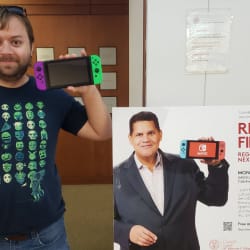Over the past decade, we've seen a surge in a trend that doesn't appear to be slowing down any time soon: video game companies buying each other. This digital arms race helps to shore up more exclusives for the major platforms while also giving indie studios larger budgets to bring their creative visions to fruition, in theory. Though we love to see smaller game studios succeed and be recognized by the larger players for their talent, there is something that can be lost when a game studio ceases to be its own entity and instead unites with the titans that this industry is all too familiar with: Sony, Microsoft, and even Netflix are getting in on game studio acquisitions. And what we may gain in the evolution of the video game assembly line, this Bessemer process of digital entertainment, doesn't make up for the creative vision and soul that's lost when these takeovers happen.
What Does It Mean To Be a Modern Indie Game Developer?

There are countless words in the video game lexicon that have lost their meaning over the years, like the ongoing argument of what designates a remaster vs. a remake. But the concept of an indie game has changed drastically. Is an indie studio one that literally fits the definition of operating independently without other controlling interests? Is it a small-scale production with a minimal team of dedicated developers working on a project? Is it something else entirely? To answer this question we need to both look at the size of the development team, as well as what financial stakes are connected to the project.
For our purposes, let's assume an indie game developer is one which both maintains creative control of its projects and isn't backed by the funding of a publisher or larger company. Sometimes these games are crowdfunded, like the success we've seen with Yacht Club Games when Shovel Knight initially came to Kickstarter. A game like Journey from thatgamecompany might be considered an indie title, but it was developed with financial backing from Sony. Or you can look at No Man's Sky, which was developed by Hello Games and published by Sony but didn't receive financial backing from that company. The definitions can get murky, and there are many truly indie game studios around the world, but it's becoming more common for these developers to be bought out by the larger competitors. The indie scene will never truly go away, but it will become more consolidated as these mergers become the norm.
Who's Responsible for Game Acquisition Escalation?

Among the capitalistic goals that so many corporations strive for, the concept of either acquiring or being acquired is nothing new. Microsoft and Sony both have the benefit of housing more under their roof than video games, so their acquisitions of software and entertainment companies go back to the '80s. In 2000, Microsoft made one of their most prolific purchases when they bought Bungie, which was developing Halo: Combat Evolved. Halo would become a launch title for the original Xbox, helping to kick off the competitive landscape of the 2000s. Microsoft would acquire several more studios over the years, but in the latter half of the last decade is when these mergers really started to take off.
What sets Microsoft apart from competitors like Sony and Nintendo is they're not so much interested in selling you an Xbox console, but rather making you a subscriber to Xbox Game Pass. The more studios they can house under one roof, the more day-one exclusives they can launch on Game Pass -- and the more enticing that service is. Presently, Xbox Game Studios is comprised of 23 game development studios, including huge names like Bethesda, Rare, Mojang, and Arkane. Currently, acquisitions tend to be aimed at larger developers, but you don't have to go very far to find that this bleeds into the indie scene. Microsoft and other companies understand it's most valuable to acquire a game studio before their games become hits, allowing them to purchase first-rate talent at a fraction of the cost. Acquisitions give Microsoft more ammo for their exclusives to help drive competition, but it does create more pressure to live up to the Xbox brand as opposed to following the original creative vision that any one of these developers may have had in the beginning.
Not to be outdone, Sony has done their due diligence to bring as many developers under one roof as possible. That includes older acquisitions like Naughty Dog in 2001 and Guerrilla Games in 2005, but in the last year alone Sony acquired Housemarque, Fabrik Games, Bluepoint Games, and Valkyrie Entertainment. Even Nintendo, a company that doesn't typically participate in acquisitions, bought Next Level Games last year, the developer behind Luigi's Mansion 3. There are certainly positives to having so much talent under one roof, but one question remains – what happens to the games that studio is actively working on?
What Games Have Been Lost in these Mergers?

Acquisitions can take many shapes. The whole team can remain intact and continue working on their projects, there can be broad layoffs, or the team can be absorbed into the larger company. This absorption is exactly what happened when Valve purchased Campo Santo in 2018. The studio had a hit with Firewatch in 2016 and were actively working on a spiritual successor called In The Valley of the Gods, an adventure game set in 1920s Egypt where you play as an Egyptologist. It looked awesome. Then the acquisition happened.
To Valve's credit, when this acquisition happened they did say the team would continue working on In The Valley of the Gods. And that game hasn't been officially cancelled, but Campo Santo developers were placed on other projects, such as Half-Life Alyx and Dota Underworlds. By pulling them away from their own game to focus on projects that Valve deemed to be higher priority, Valve effectively took away creative control from that team. We might get In The Valley of the Gods someday, but nothing recent has been announced about it, and it's unlikely anyone with first-hand knowledge of the project would be willing to confirm or deny details surrounding it. So for the foreseeable future it remains in purgatory, uncertain if it'll ever see the light of day.
Even larger studios are subject to the pull of their parent companies. Shortly after Disney purchased Lucasfilm, LucasArts was shuttered. This led to the cancellation of all their projects, including the anticipated game Star Wars 1313. This game was supposed to feature a young Boba Fett in the days before the prequel films and showcase the underworld of Coruscant. When EA took over the gaming license for Star Wars, they saw the potential for Star Wars 1313. They used it to inspire the creation of a new game that was handed over to Visceral Games, the developer of Dead Space. This was short lived, however, as Visceral Games would eventually be shut down and their ongoing projects cancelled as well. EA would go onto create breakout hits like Star Wars Jedi: Fallen Order, but at the cost of its predecessors that never got to see the light of day. Only time will tell what the future of Star Wars games will look like.
During the global pandemic, more and more and acquisitions took place as companies continued to invest money to add studios under their roofs. Whether you followed the sale and break up of WB Games last year, making the fate of upcoming games like Hogwarts Legacy and Suicide Squad Kill the Justice League uncertain at the time, or have even looked at the number of developers that EA has acquired in the past year, the consolidation of the video game industry is something that's worth paying attention to. Diversity and competition breed creativity, and indie studios are where we get some of the most amazing games year after year. When only the AAA players call the shots, we all lose.
Have you had a game you were looking forward to get cancelled or delayed due to a merger, or do you get excited when you see indie studios be recognized for their talent by the larger corporations? Let us know in the comments!
Have a tip, or want to point out something we missed? Leave a Comment or e-mail us at tips@techraptor.net












